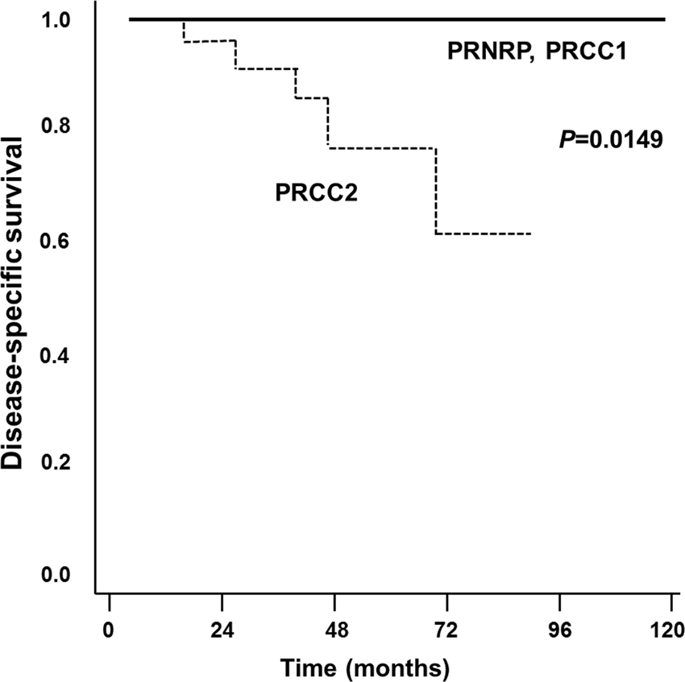当前位置:
X-MOL 学术
›
Modern Pathol.
›
论文详情
Our official English website, www.x-mol.net, welcomes your
feedback! (Note: you will need to create a separate account there.)
Recurrent KRAS mutations identified in papillary renal neoplasm with reverse polarity-a comparative study with papillary renal cell carcinoma.
Modern Pathology ( IF 7.1 ) Pub Date : 2020-01-17 , DOI: 10.1038/s41379-019-0420-8 Sung Sun Kim 1 , Yong Mee Cho 2 , Gi Hwan Kim 2 , Keun Hong Kee 3 , Hun-Soo Kim 4 , Kyoung Min Kim 5 , Jo-Heon Kim 1 , Chan Choi 1
Modern Pathology ( IF 7.1 ) Pub Date : 2020-01-17 , DOI: 10.1038/s41379-019-0420-8 Sung Sun Kim 1 , Yong Mee Cho 2 , Gi Hwan Kim 2 , Keun Hong Kee 3 , Hun-Soo Kim 4 , Kyoung Min Kim 5 , Jo-Heon Kim 1 , Chan Choi 1
Affiliation

|
Comprehensive molecular analyses revealed that papillary renal cell carcinoma (PRCC) is a heterogenous entity. Papillary renal neoplasm with reverse polarity (PRNRP) is a subset of PRCC with characteristic histomorphologies such as low-grade nuclear features, inverted nuclear location, eosinophilic cytoplasm, and indolent clinical behavior. We tried to define the molecular, clinicopathological, histologic, and immunohistochemical features of PRNRP by comparing them with type 1 PRCC (PRCC1) and type 2 PRCC (PRCC2). A cohort of 30 PRNRP, 23 PRCC1, and 26 PRCC2 cases was used. Targeted sequencing of 90 cancer-related genes including KRAS was performed in 26 PRNRP tumor samples. PNA-mediated clamping PCR of KRAS was performed using paired normal and tumor DNA from 30 PRNRP, 23 PRCC1, and 26 PRCC2 cases. Tissue microarray slides were made in three cores per tumor, which were stained with cytokeratin 7 (CK7), alpha-methylacyl-CoA racemase (AMACR), epithelial membrane antigen (EMA), E-cadherin, vimentin, and CD10. Recurrent mutations in KRAS were detected in 28 of the 30 PRNRPs. However, there were no KRAS mutations in any PRCC1 or PRCC2 cases. PRNRP exhibited distinct clinicopathological features: small tumor size, lower pathologic T stage, and no disease-specific death during the follow-up period. Histologically, peritumoral lymphoid aggregation, prominent papillary architecture (>80% of tumor), hyalinized papillae, inverted nuclear location, and lower nuclear grade were observed. PRNRP was usually positive for CK7, AMACR, EMA, and E-cadherin, and negative for CD10. The findings suggest that PRNRP is a subtype of papillary renal neoplasm that is different from PRCC1 or PRCC2 in terms of molecular, clinicopathological, histological, and immunohistochemical features.
中文翻译:

在具有反极性的乳头状肾肿瘤中发现复发性 KRAS 突变——与乳头状肾细胞癌的比较研究。
综合分子分析表明,乳头状肾细胞癌 (PRCC) 是一种异质性实体。具有反极性的乳头状肾肿瘤 (PRNRP) 是 PRCC 的一个子集,具有特征性的组织形态学特征,例如低级别核特征、倒核位置、嗜酸性细胞质和惰性临床行为。我们试图通过将 PRNRP 与 1 型 PRCC (PRCC1) 和 2 型 PRCC (PRCC2) 进行比较来定义 PRNRP 的分子、临床病理学、组织学和免疫组织化学特征。使用了 30 例 PRNRP、23 例 PRCC1 和 26 例 PRCC2 病例的队列。在 26 个 PRNRP 肿瘤样本中对包括 KRAS 在内的 90 个癌症相关基因进行了靶向测序。使用来自 30 个 PRNRP、23 个 PRCC1 和 26 个 PRCC2 病例的配对正常和肿瘤 DNA 进行 KRAS 的 PNA 介导的钳夹 PCR。每个肿瘤在三个核心中制作组织微阵列载玻片,用细胞角蛋白 7 (CK7)、α-甲基酰基辅酶 A 消旋酶 (AMACR)、上皮膜抗原 (EMA)、E-钙粘蛋白、波形蛋白和 CD10 染色。在 30 个 PRNRP 中的 28 个中检测到 KRAS 的反复突变。然而,在任何 PRCC1 或 PRCC2 病例中都没有 KRAS 突变。PRNRP 表现出明显的临床病理特征:肿瘤体积小,病理 T 分期较低,随访期间无疾病特异性死亡。在组织学上,观察到瘤周淋巴聚集、突出的乳头状结构(>80% 的肿瘤)、透明乳头、倒核位置和较低的核分级。PRNRP 通常对 CK7、AMACR、EMA 和 E-钙粘蛋白呈阳性,对 CD10 呈阴性。
更新日期:2020-01-17
中文翻译:

在具有反极性的乳头状肾肿瘤中发现复发性 KRAS 突变——与乳头状肾细胞癌的比较研究。
综合分子分析表明,乳头状肾细胞癌 (PRCC) 是一种异质性实体。具有反极性的乳头状肾肿瘤 (PRNRP) 是 PRCC 的一个子集,具有特征性的组织形态学特征,例如低级别核特征、倒核位置、嗜酸性细胞质和惰性临床行为。我们试图通过将 PRNRP 与 1 型 PRCC (PRCC1) 和 2 型 PRCC (PRCC2) 进行比较来定义 PRNRP 的分子、临床病理学、组织学和免疫组织化学特征。使用了 30 例 PRNRP、23 例 PRCC1 和 26 例 PRCC2 病例的队列。在 26 个 PRNRP 肿瘤样本中对包括 KRAS 在内的 90 个癌症相关基因进行了靶向测序。使用来自 30 个 PRNRP、23 个 PRCC1 和 26 个 PRCC2 病例的配对正常和肿瘤 DNA 进行 KRAS 的 PNA 介导的钳夹 PCR。每个肿瘤在三个核心中制作组织微阵列载玻片,用细胞角蛋白 7 (CK7)、α-甲基酰基辅酶 A 消旋酶 (AMACR)、上皮膜抗原 (EMA)、E-钙粘蛋白、波形蛋白和 CD10 染色。在 30 个 PRNRP 中的 28 个中检测到 KRAS 的反复突变。然而,在任何 PRCC1 或 PRCC2 病例中都没有 KRAS 突变。PRNRP 表现出明显的临床病理特征:肿瘤体积小,病理 T 分期较低,随访期间无疾病特异性死亡。在组织学上,观察到瘤周淋巴聚集、突出的乳头状结构(>80% 的肿瘤)、透明乳头、倒核位置和较低的核分级。PRNRP 通常对 CK7、AMACR、EMA 和 E-钙粘蛋白呈阳性,对 CD10 呈阴性。











































 京公网安备 11010802027423号
京公网安备 11010802027423号